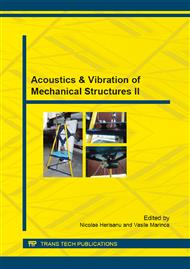p.273
p.278
p.284
p.290
p.295
p.303
p.312
p.317
p.323
Evaluation of the Human Body Equilibrium in a Vibration Environment
Abstract:
In the human body, vibrations are generated by internal or external sources. Because of the soft tissues, bones, joints, internal organs and also because of its anatomical particularities components in general, the human body is a complex vibratory system. The vibrations from external sources can be transmitted to the human body when it is positioned in different manners: standing, sitting, recumbent and moving or at work. The effect of vibration on the human body is related to the natural frequency of affected parts in the human body. This paper studies the dynamic characteristics of a human body system in a vibration environment and sets limits to which the balance is affected. The main result is a multi degrees of freedom lumped parameter model. The model provides an analytical tool for human body dynamics research. The relative displacements of human parts are evaluated, which can be a basis for the assessment of vibration risk and setting limits for keeping human balance.
Info:
Periodical:
Pages:
295-299
Citation:
Online since:
October 2015
Authors:
Keywords:
Price:
Сopyright:
© 2015 Trans Tech Publications Ltd. All Rights Reserved
Share:
Citation:


